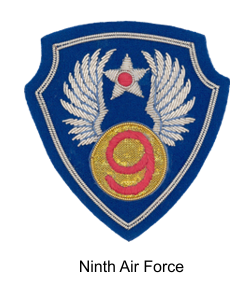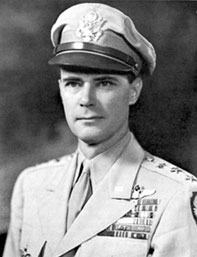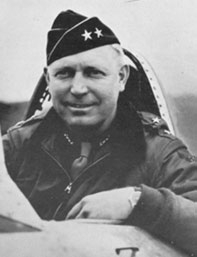A Brief Historical Survey

Born in Egypt and bred to fighting strength in the Western Desert, the Ninth Air Force has stretched its colorful career around three thousand mile crescent from the Nile to the Rhine. In two eventful years it grew from the smallest to one of the largest American Air Forces. It has been sword and shield for ground forces. It has shared in the defeat of Axis Africa and the winning of the Mediterranean for the Allies. It has helped to lead the Allied Forces across the English Channel and through France to the gates of the Rhineland.
Officially the Ninth began its existence in Cairo, on June 28th, 1942 as the United States Army Middle East Air Force. Major General Lewis H. Brereton was called from command of the Tenth Air Force in India to organize the new force. Its purpose was to supplement British air units in support of the British Eighth Army at that time holding out desperately against the eastward sweeping Axis Afrika Korps. General Brereton and his Chief of Staff, then Colonel, but soon to be Brigadier General Victor H. Strahm, brought with them a few headquarters officers and one squadron of Flying Fortresses. They short-stopped the crack Halverson detachment of Liberators on its airborne journey to China and vectored it over to the Middle East. From these two tactical units they fashioned their First Provisional Group. One Group of fighters arrived later, then another and still later medium bombers. But the Air Force never grew to great size. It was employed more as a swift darting lance than as a crushing power.
Its bombers stuck with telling effect at Axis supply lines across the Mediterranean and denied to the enemy the fuel required for his highly mechanized forces.
Over the hectic road back from Alamein to Cape Bon the Ninth's fighters and medium bombers, with the Royal Air Force and South African Air Force, supported General Montgomery's hard fighting Eighth Army.
They surprised German transports ferrying escaping troops over to Italy. RAF fighters engaged the escort while the P-40's all but destroyed the enemy transport fleet.
The Ninth's air transport C-47 ferried an enormous amount of supplies daily, across desert wastes where there were few roads, and no railways, The Ninth's service forces improvised, patched and waged successful war against sand, heat and engine-eating dust.
Throughout most of the African campaign the Ninth maintained headquarters in Cairo. Brigadier General U.G. Ent's Bomber Command moved to Benghazi as the enemy moved out, and Brigadier General Auby C. Strickland took his Fighter Command to Tripoli after its liberation.
Outstanding bomber operation of the Ninth in the Middle East came on August 1, 1943. It was a maximum distance raid by its two groups of heavies, together with three groups from the Britain - based Eighth Air Force, on the Ploesti oil refineries -vital fuel source for the Axis, deep in Roumania. The attack, flown through 2,600 miles of difficult skies, was daring in its concept and in its execution. Ninth heavies were also the first bombers over Naples and participated in the large-scale raid on Rome's marshalling yards.

Curtiss P-40F's of the 57th FG preparing for take-off from a Western Desert base.
Outstanding achievement of the Ninth fighters was an air battle over Cape Bon in which Colonel Arthur Salisbury's Fifty-Seventh Group accounted for 74 enemy planes. They surprised German transports ferrying escaping troops over to Italy. RAF fighters engaged the escort while the P-40's all but destroyed the enemy transport fleet.
The Ninth remained in Africa throughout the victory in Sicily, the invasion of the Italian boot and the fall of Fascism. By then the Axis had lost the Mediterranean. It was the end of the beginning.
The Ninth marshalled at Suez for the move from Africa to England. Advance elements went by air, but the bulk of the forces traveled by sea during the month of October.
The Force was officially transferred to the United Kingdom with the arrival of General Brereton at its new headquarters, Sunninghill Park, near Ascot, Berks, on October 16th, 1943. The Ninth then entered upon a period of reorganization and rapid build-up which was to make it one of the world's largest air forces. It was being prepared for its greatest assignment - the support of the Allied invasion of Europe from the west.



